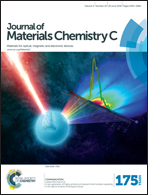Enhancement of lasing in organic gain media assisted by the metallic nanoparticles–metallic film plasmonic hybrid structure
Abstract
Metallic films are widely used in many micro-cavities or as electrodes. However, the quenching of fluorescent molecules and the large absorption loss of metallic films are generally considered fatal for lasing. In this article, we present the enhanced lasing of an organic gain medium in a planar waveguide, assisted by the plasmonic hybrid structure of an Ag nanoparticles (NPs)–Ag film. Compared to the devices of gain media deposited on glass, Ag film, and Ag NPs island film, the lowest lasing threshold was achieved by the gain medium deposited on the Ag NPs–Ag film hybrid structure. This is attributed to the hybrid plasmonic coupling between the localized surface plasmons of Ag NPs and the delocalized surface plasmon polariton of the Ag film, leading a more intense localized electric field. In addition, the reinjection and confinement of the leaking photons into the gain medium by the external feedback of the Ag film also contributes to the enhanced lasing. Our results could provide us with a unique approach to effectively avoid the negative effect of the metallic film, enhance the lasing gain of organic dye molecules, and realize a lower pumped threshold and stronger lasing.


 Please wait while we load your content...
Please wait while we load your content...